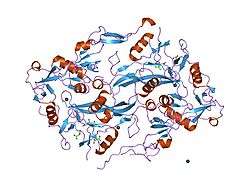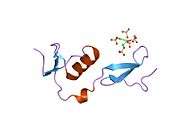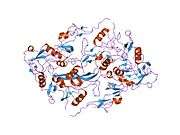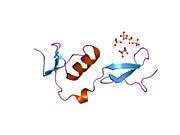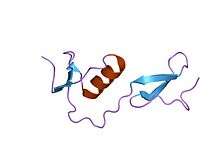Follistatin
Follistatin also known as activin-binding protein is a protein that in humans is encoded by the FST gene.[5][6] Follistatin is an autocrine glycoprotein that is expressed in nearly all tissues of higher animals.[6]
Its primary function is the binding and bioneutralization of members of the TGF-β superfamily, with a particular focus on activin, a paracrine hormone.
An earlier name for the same protein was FSH-suppressing protein (FSP). At the time of its initial isolation from follicular fluid, it was found to inhibit the anterior pituitary's secretion of follicle-stimulating hormone (FSH).
Biochemistry
Follistatin is part of the inhibin-activin-follistatin axis.
Currently there are three reported isoforms, FS-288, FS-300, and FS-315. Two, FS-288 and FS-315, are known to be created by alternative splicing of the primary mRNA transcript. FS-300 (porcine follistatin) is thought to be the product of posttranslational modification via truncation of the C-terminal domain from the primary amino-acid chain.
Although FS is ubiquitous its highest concentration has been found to be in the female ovary, followed by the skin.
The activin-binding protein follistatin is produced by folliculostellate (FS) cells of the anterior pituitary. FS cells make numerous contacts with the classical endocrine cells of the anterior pituitary including gonadotrophs.
In the tissues activin has a strong role in cellular proliferation, thereby making follistatin the safeguard against uncontrolled cellular proliferation and also allowing it to function as an instrument of cellular differentiation. Both of these roles are vital in tissue rebuilding and repair, and may account for follistatin's high presence in the skin.
In the blood, activin and follistatin are both known to be involved in the inflammatory response following tissue injury or pathogenic incursion. The source of follistatin in circulating blood plasma has yet to be determined, but due to its autocrine nature speculation suggests the endothelial cells lining all blood vessels, or the macrophages and monocytes also circulating within the whole blood, may be sources.
Follistatin is involved in the development of the embryo. It has inhibitory action on bone morphogenic proteins (BMPs); BMPs induce the ectoderm to become epidermal ectoderm. Inhibition of BMPs allows neuroectoderm to arise from ectoderm, a process which eventually forms the neural plate. Other inhibitors involved in this process are noggin and chordin.
Follistatin and BMPs are also known to play a role in folliculogenesis within the ovary. The main role of follistatin in the oestrus/menstrus ovary, so far, appears to be progression of the follicle from early antral to antral/dominant, and importantly the promotion of cellular differentiation of the estrogen producing granulosa cells (GC) of the dominant follicle into the progesterone producing large lutein cells (LLC) of the corpus luteum.
Clinical significance
Follistatin is being studied for its role in regulation of muscle growth in mice, as an antagonist to myostatin (also known as GDF-8, a TGF superfamily member) which inhibits excessive muscle growth. Lee & McPherron demonstrated that inhibition of GDF-8, either by genetic elimination (knockout mice) or by increasing the amount of follistatin, resulted in greatly increased muscle mass.[7][8] In 2009, research with macaque monkeys demonstrated that regulating follistatin via gene therapy also resulted in muscle growth and increases in strength. This research paves the way for human clinical trials, which are hoped to begin in the summer of 2010 on Inclusion body myositis.[9]
A study has also shown that increased levels of follistatin, by leading to increased muscle mass of certain core muscular groups, can increase life expectancy in cases of spinal muscular atrophy (SMA) in animal models.[10]
It is also being investigated for its involvement in polycystic ovary syndrome (PCOS), though there is debate as to its direct role in this infertility disease.
References
- 1 2 3 GRCh38: Ensembl release 89: ENSG00000134363 - Ensembl, May 2017
- 1 2 3 GRCm38: Ensembl release 89: ENSMUSG00000021765 - Ensembl, May 2017
- ↑ "Human PubMed Reference:".
- ↑ "Mouse PubMed Reference:".
- ↑ Ueno N, Ling N, Ying SY, Esch F, Shimasaki S, Guillemin R (December 1987). "Isolation and partial characterization of follistatin: a single-chain Mr 35,000 monomeric protein that inhibits the release of follicle-stimulating hormone". Proc. Natl. Acad. Sci. U.S.A. 84 (23): 8282–6. doi:10.1073/pnas.84.23.8282. PMC 299526. PMID 3120188.
- 1 2 Tortoriello DV, Sidis Y, Holtzman DA, Holmes WE, Schneyer AL (August 2001). "Human follistatin-related protein: a structural homologue of follistatin with nuclear localization". Endocrinology. 142 (8): 3426–34. doi:10.1210/en.142.8.3426. PMID 11459787.
- ↑ Lee SJ, McPherron AC (2001). "Regulation of myostatin activity and muscle growth". Proc. Natl. Acad. Sci. U.S.A. 98 (16): 9306–11. doi:10.1073/pnas.151270098. PMC 55416. PMID 11459935.
- ↑ "'Mighty mice' made mightier". Retrieved 2008-02-26.
- ↑ "Success Boosting Monkey Muscle Could Help Humans". NPR. 11 Nov 2009. Retrieved 2009-11-12.
- ↑ Rose FF, Mattis VB, Rindt H, Lorson CL (December 2008). "Delivery of recombinant follistatin lessens disease severity in a mouse model of Spinal Muscular Atrophy". Hum. Mol. Genet. 18 (6): 997–1005. doi:10.1093/hmg/ddn426. PMC 2649020. PMID 19074460.
Further reading
- Thompson TB, Lerch TF, Cook RW, et al. (2005). "The structure of the follistatin:activin complex reveals antagonism of both type I and type II receptor binding". Dev. Cell. 9 (4): 535–43. doi:10.1016/j.devcel.2005.09.008. PMID 16198295.
- Nakatani M, Takehara Y, Sugino H, et al. (2008). "Transgenic expression of a myostatin inhibitor derived from follistatin increases skeletal muscle mass and ameliorates dystrophic pathology in mdx mice". FASEB J. 22 (2): 477–87. doi:10.1096/fj.07-8673com. PMID 17893249.
- Lambert-Messerlian G, Eklund E, Pinar H, et al. (2007). "Activin subunit and receptor expression in normal and cleft human fetal palate tissues". Pediatr. Dev. Pathol. 10 (6): 436–45. doi:10.2350/06-05-0087.1. PMID 18001154.
- Walsh S, Metter EJ, Ferrucci L, Roth SM (2007). "Activin-type II receptor B (ACVR2B) and follistatin haplotype associations with muscle mass and strength in humans". J. Appl. Physiol. 102 (6): 2142–8. doi:10.1152/japplphysiol.01322.2006. PMC 2646094. PMID 17347381.
- Ogino H, Yano S, Kakiuchi S, et al. (2008). "Follistatin suppresses the production of experimental multiple-organ metastasis by small cell lung cancer cells in natural killer cell-depleted SCID mice". Clin. Cancer Res. 14 (3): 660–7. doi:10.1158/1078-0432.CCR-07-1221. PMID 18245525.
- Reis FM, Nascimento LL, Tsigkou A, et al. (2007). "Activin A and follistatin in menstrual blood: low concentrations in women with dysfunctional uterine bleeding". Reprod Sci. 14 (4): 383–9. doi:10.1177/1933719107303985. PMID 17644811.
- Yerges LM, Klei L, Cauley JA, et al. (2009). "A High-Density Association Study of 383 Candidate Genes for Volumetric Bone Density at the Femoral Neck and Lumbar Spine among Older Men". J. Bone Miner. Res. 24 (12): HASH(0x14c4c40). doi:10.1359/jbmr.090524. PMC 2791518. PMID 19453261.
- Blount AL, Vaughan JM, Vale WW, Bilezikjian LM (2008). "A Smad-binding element in intron 1 participates in activin-dependent regulation of the follistatin gene". J. Biol. Chem. 283 (11): 7016–26. doi:10.1074/jbc.M709502200. PMID 18184649.
- Eichberger T, Kaser A, Pixner C, et al. (2008). "GLI2-specific transcriptional activation of the bone morphogenetic protein/activin antagonist follistatin in human epidermal cells". J. Biol. Chem. 283 (18): 12426–37. doi:10.1074/jbc.M707117200. PMC 2430996. PMID 18319260.
- Jones MR, Wilson SG, Mullin BH, et al. (2007). "Polymorphism of the follistatin gene in polycystic ovary syndrome". Mol. Hum. Reprod. 13 (4): 237–41. doi:10.1093/molehr/gal120. PMID 17284512.
- Torres PB, Florio P, Ferreira MC, et al. (2007). "Deranged expression of follistatin and follistatin-like protein in women with ovarian endometriosis". Fertil. Steril. 88 (1): 200–5. doi:10.1016/j.fertnstert.2006.11.105. PMID 17296189.
- Sidis Y, Mukherjee A, Keutmann H, et al. (2006). "Biological activity of follistatin isoforms and follistatin-like-3 is dependent on differential cell surface binding and specificity for activin, myostatin, and bone morphogenetic proteins". Endocrinology. 147 (7): 3586–97. doi:10.1210/en.2006-0089. PMID 16627583.
- Grusch M, Drucker C, Peter-Vörösmarty B, et al. (2006). "Deregulation of the activin/follistatin system in hepatocarcinogenesis". J. Hepatol. 45 (5): 673–80. doi:10.1016/j.jhep.2006.06.014. PMID 16935389.
- Chen M, Sinha M, Luxon BA, et al. (2009). "Integrin alpha6beta4 controls the expression of genes associated with cell motility, invasion, and metastasis, including S100A4/metastasin". J. Biol. Chem. 284 (3): 1484–94. doi:10.1074/jbc.M803997200. PMC 2615501. PMID 19011242.
- Blount AL, Schmidt K, Justice NJ, et al. (2009). "FoxL2 and Smad3 coordinately regulate follistatin gene transcription". J. Biol. Chem. 284 (12): 7631–45. doi:10.1074/jbc.M806676200. PMC 2658057. PMID 19106105.
- Phillips DJ, de Kretser DM (1998). "Follistatin: a multifunctional regulatory protein". Frontiers in Neuroendocrinology. 19 (4): 287–322. doi:10.1006/frne.1998.0169. PMID 9799587.
- Chang SY, Kang HY, Lan KC, et al. (2006). "Expression of inhibin-activin subunits, follistatin and smads in granulosa-luteal cells collected at oocyte retrieval". J. Assist. Reprod. Genet. 23 (9–10): 385–92. doi:10.1007/s10815-006-9068-7. PMC 3455100. PMID 17053951.
- Kostek MA, Angelopoulos TJ, Clarkson PM, et al. (2009). "Myostatin and follistatin polymorphisms interact with muscle phenotypes and ethnicity". Medicine & Science in Sports & Exercise. 41 (5): 1063–71. doi:10.1249/MSS.0b013e3181930337. PMC 4147954. PMID 19346981.
- Flanagan JN, Linder K, Mejhert N, et al. (2009). "Role of follistatin in promoting adipogenesis in women". J. Clin. Endocrinol. Metab. 94 (8): 3003–9. doi:10.1210/jc.2008-2005. PMC 3214594. PMID 19470636.
- Peng C, Ohno T, Khorasheh S, Leung PC (1996). "Activin and follistatin as local regulators in the human ovary". Biol. Signals. 5 (2): 81–9. doi:10.1159/000109177. PMID 8836491.
External links
- Follistatin at the US National Library of Medicine Medical Subject Headings (MeSH)
